Implementing Change: An Analysis of Kotter's 8-Step Model
VerifiedAdded on 2023/06/11
|7
|1587
|258
Essay
AI Summary
This essay provides an overview of change management and focuses on John Kotter's 8-step change management model. It discusses the importance of change management in helping organizations incorporate changes in their working procedures. The essay highlights each of the eight stages of Kotter’s model: creating a sense of urgency, forming a powerful coalition, creating a vision, communicating the vision, empowering broad-based action, generating short-term wins, consolidating gains to produce more changes, and anchoring changes in the organizational work culture. It emphasizes the need for leaders to explain the benefits of changes, form strong teams, develop a clear vision, and communicate effectively to ensure successful implementation. The essay concludes that following Kotter's model in a proper sequence is essential for organizations to incorporate changes effectively.
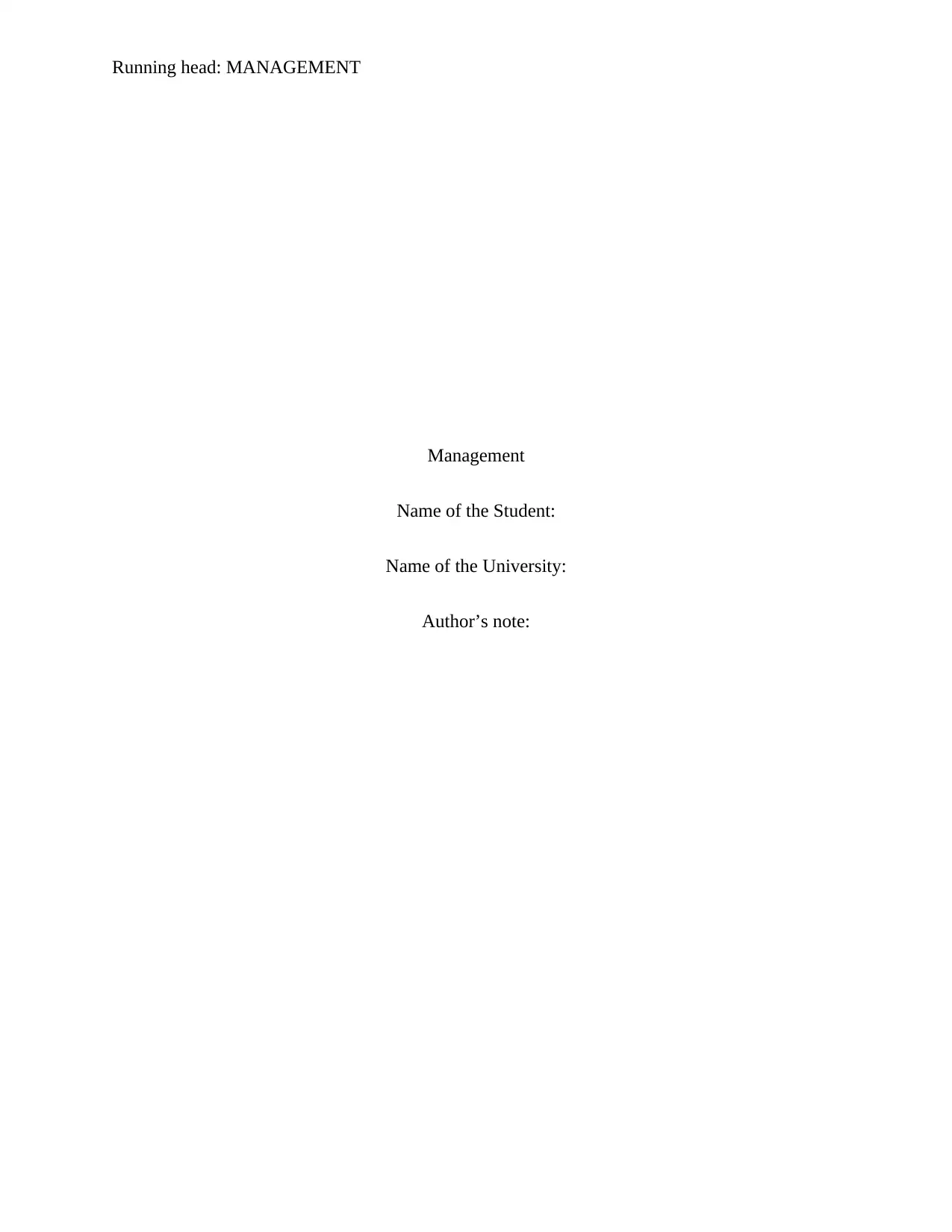
Running head: MANAGEMENT
Management
Name of the Student:
Name of the University:
Author’s note:
Management
Name of the Student:
Name of the University:
Author’s note:
Paraphrase This Document
Need a fresh take? Get an instant paraphrase of this document with our AI Paraphraser
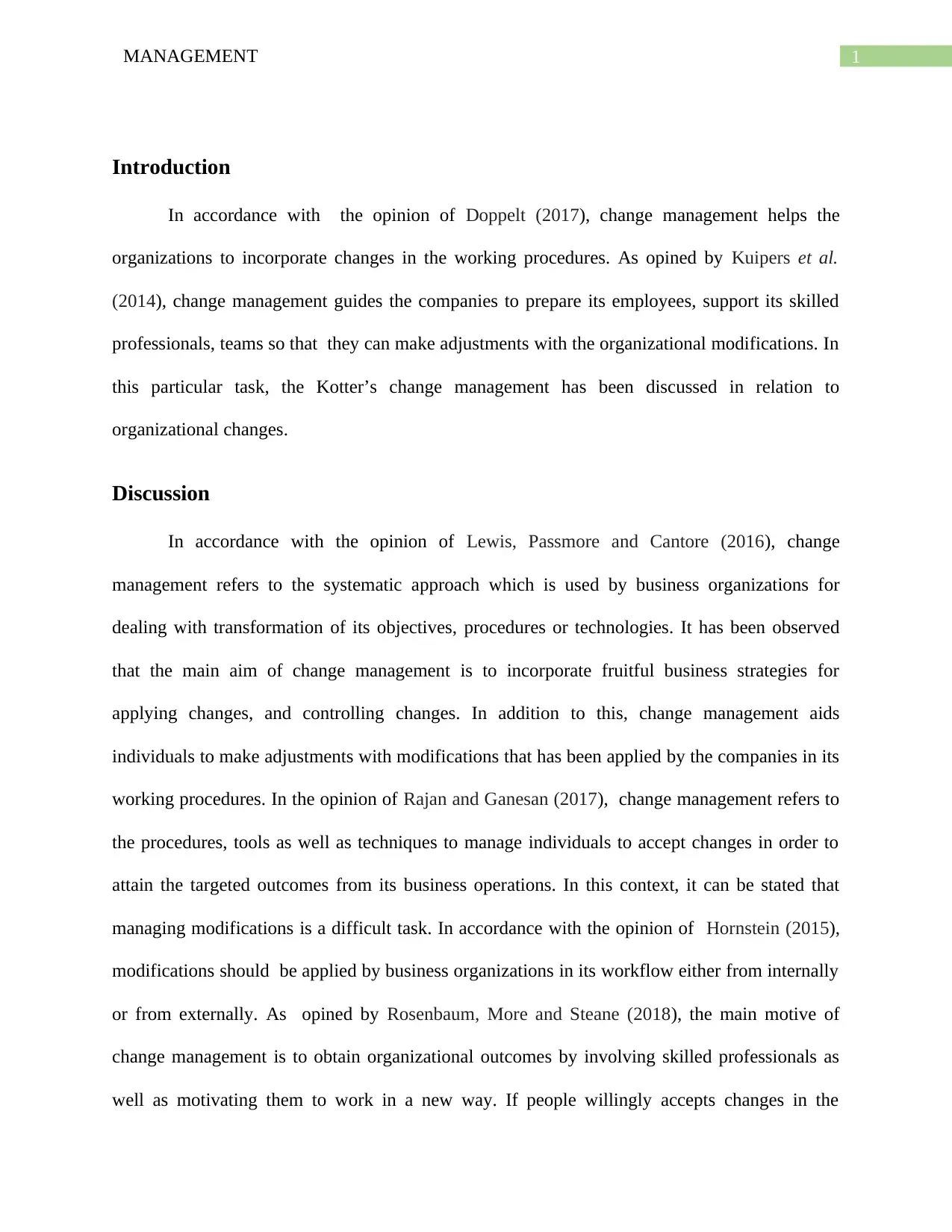
1MANAGEMENT
Introduction
In accordance with the opinion of Doppelt (2017), change management helps the
organizations to incorporate changes in the working procedures. As opined by Kuipers et al.
(2014), change management guides the companies to prepare its employees, support its skilled
professionals, teams so that they can make adjustments with the organizational modifications. In
this particular task, the Kotter’s change management has been discussed in relation to
organizational changes.
Discussion
In accordance with the opinion of Lewis, Passmore and Cantore (2016), change
management refers to the systematic approach which is used by business organizations for
dealing with transformation of its objectives, procedures or technologies. It has been observed
that the main aim of change management is to incorporate fruitful business strategies for
applying changes, and controlling changes. In addition to this, change management aids
individuals to make adjustments with modifications that has been applied by the companies in its
working procedures. In the opinion of Rajan and Ganesan (2017), change management refers to
the procedures, tools as well as techniques to manage individuals to accept changes in order to
attain the targeted outcomes from its business operations. In this context, it can be stated that
managing modifications is a difficult task. In accordance with the opinion of Hornstein (2015),
modifications should be applied by business organizations in its workflow either from internally
or from externally. As opined by Rosenbaum, More and Steane (2018), the main motive of
change management is to obtain organizational outcomes by involving skilled professionals as
well as motivating them to work in a new way. If people willingly accepts changes in the
Introduction
In accordance with the opinion of Doppelt (2017), change management helps the
organizations to incorporate changes in the working procedures. As opined by Kuipers et al.
(2014), change management guides the companies to prepare its employees, support its skilled
professionals, teams so that they can make adjustments with the organizational modifications. In
this particular task, the Kotter’s change management has been discussed in relation to
organizational changes.
Discussion
In accordance with the opinion of Lewis, Passmore and Cantore (2016), change
management refers to the systematic approach which is used by business organizations for
dealing with transformation of its objectives, procedures or technologies. It has been observed
that the main aim of change management is to incorporate fruitful business strategies for
applying changes, and controlling changes. In addition to this, change management aids
individuals to make adjustments with modifications that has been applied by the companies in its
working procedures. In the opinion of Rajan and Ganesan (2017), change management refers to
the procedures, tools as well as techniques to manage individuals to accept changes in order to
attain the targeted outcomes from its business operations. In this context, it can be stated that
managing modifications is a difficult task. In accordance with the opinion of Hornstein (2015),
modifications should be applied by business organizations in its workflow either from internally
or from externally. As opined by Rosenbaum, More and Steane (2018), the main motive of
change management is to obtain organizational outcomes by involving skilled professionals as
well as motivating them to work in a new way. If people willingly accepts changes in the
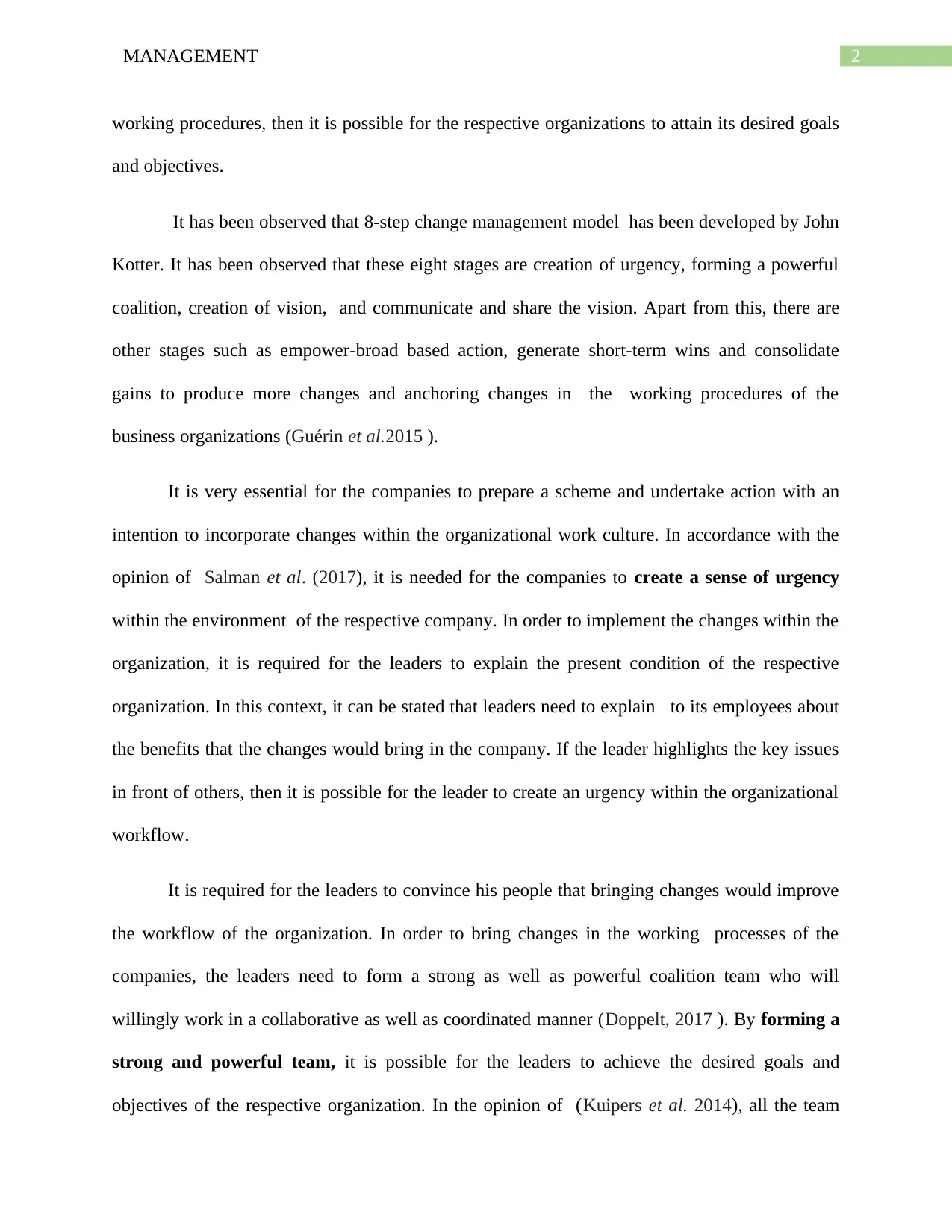
2MANAGEMENT
working procedures, then it is possible for the respective organizations to attain its desired goals
and objectives.
It has been observed that 8-step change management model has been developed by John
Kotter. It has been observed that these eight stages are creation of urgency, forming a powerful
coalition, creation of vision, and communicate and share the vision. Apart from this, there are
other stages such as empower-broad based action, generate short-term wins and consolidate
gains to produce more changes and anchoring changes in the working procedures of the
business organizations (Guérin et al.2015 ).
It is very essential for the companies to prepare a scheme and undertake action with an
intention to incorporate changes within the organizational work culture. In accordance with the
opinion of Salman et al. (2017), it is needed for the companies to create a sense of urgency
within the environment of the respective company. In order to implement the changes within the
organization, it is required for the leaders to explain the present condition of the respective
organization. In this context, it can be stated that leaders need to explain to its employees about
the benefits that the changes would bring in the company. If the leader highlights the key issues
in front of others, then it is possible for the leader to create an urgency within the organizational
workflow.
It is required for the leaders to convince his people that bringing changes would improve
the workflow of the organization. In order to bring changes in the working processes of the
companies, the leaders need to form a strong as well as powerful coalition team who will
willingly work in a collaborative as well as coordinated manner (Doppelt, 2017 ). By forming a
strong and powerful team, it is possible for the leaders to achieve the desired goals and
objectives of the respective organization. In the opinion of (Kuipers et al. 2014), all the team
working procedures, then it is possible for the respective organizations to attain its desired goals
and objectives.
It has been observed that 8-step change management model has been developed by John
Kotter. It has been observed that these eight stages are creation of urgency, forming a powerful
coalition, creation of vision, and communicate and share the vision. Apart from this, there are
other stages such as empower-broad based action, generate short-term wins and consolidate
gains to produce more changes and anchoring changes in the working procedures of the
business organizations (Guérin et al.2015 ).
It is very essential for the companies to prepare a scheme and undertake action with an
intention to incorporate changes within the organizational work culture. In accordance with the
opinion of Salman et al. (2017), it is needed for the companies to create a sense of urgency
within the environment of the respective company. In order to implement the changes within the
organization, it is required for the leaders to explain the present condition of the respective
organization. In this context, it can be stated that leaders need to explain to its employees about
the benefits that the changes would bring in the company. If the leader highlights the key issues
in front of others, then it is possible for the leader to create an urgency within the organizational
workflow.
It is required for the leaders to convince his people that bringing changes would improve
the workflow of the organization. In order to bring changes in the working processes of the
companies, the leaders need to form a strong as well as powerful coalition team who will
willingly work in a collaborative as well as coordinated manner (Doppelt, 2017 ). By forming a
strong and powerful team, it is possible for the leaders to achieve the desired goals and
objectives of the respective organization. In the opinion of (Kuipers et al. 2014), all the team
⊘ This is a preview!⊘
Do you want full access?
Subscribe today to unlock all pages.

Trusted by 1+ million students worldwide
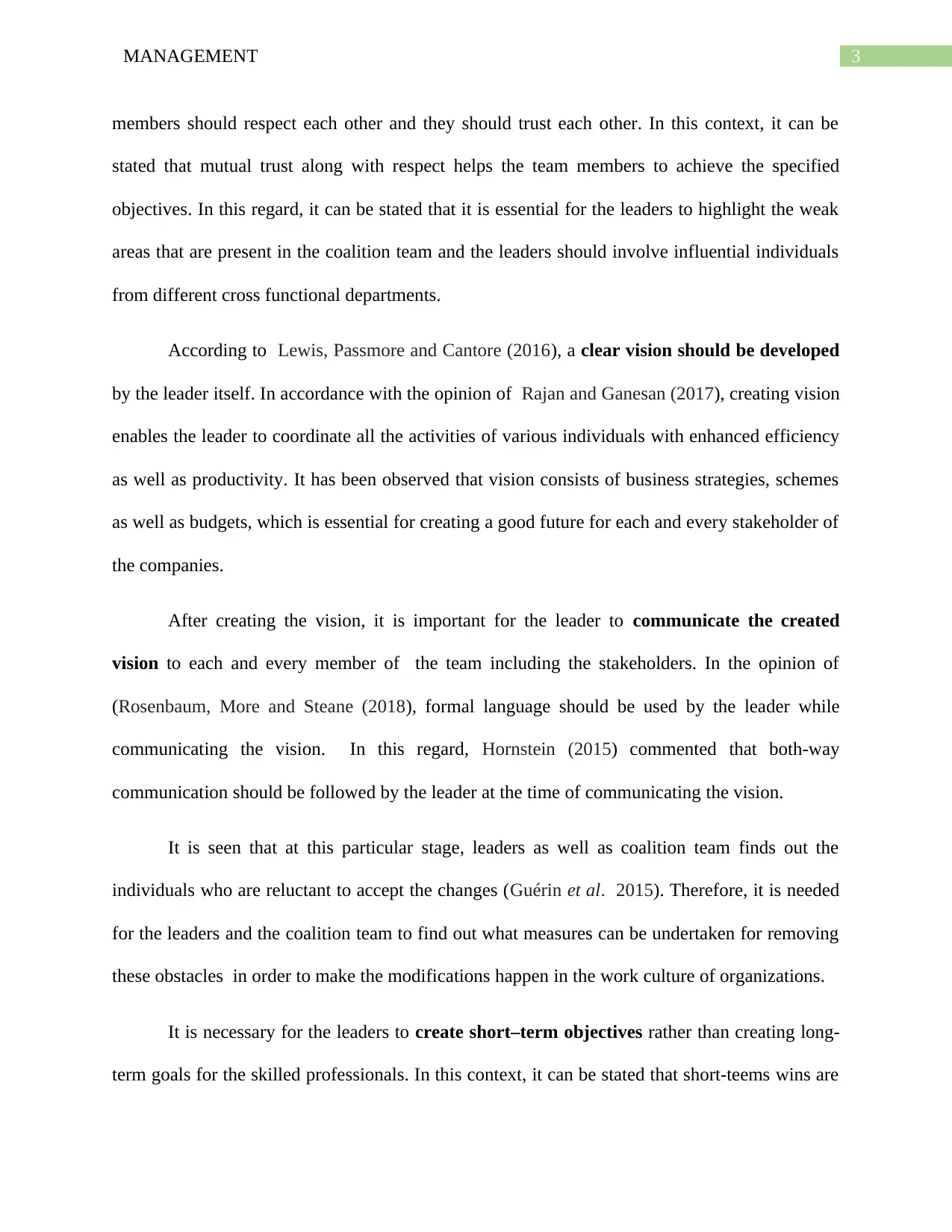
3MANAGEMENT
members should respect each other and they should trust each other. In this context, it can be
stated that mutual trust along with respect helps the team members to achieve the specified
objectives. In this regard, it can be stated that it is essential for the leaders to highlight the weak
areas that are present in the coalition team and the leaders should involve influential individuals
from different cross functional departments.
According to Lewis, Passmore and Cantore (2016), a clear vision should be developed
by the leader itself. In accordance with the opinion of Rajan and Ganesan (2017), creating vision
enables the leader to coordinate all the activities of various individuals with enhanced efficiency
as well as productivity. It has been observed that vision consists of business strategies, schemes
as well as budgets, which is essential for creating a good future for each and every stakeholder of
the companies.
After creating the vision, it is important for the leader to communicate the created
vision to each and every member of the team including the stakeholders. In the opinion of
(Rosenbaum, More and Steane (2018), formal language should be used by the leader while
communicating the vision. In this regard, Hornstein (2015) commented that both-way
communication should be followed by the leader at the time of communicating the vision.
It is seen that at this particular stage, leaders as well as coalition team finds out the
individuals who are reluctant to accept the changes (Guérin et al. 2015). Therefore, it is needed
for the leaders and the coalition team to find out what measures can be undertaken for removing
these obstacles in order to make the modifications happen in the work culture of organizations.
It is necessary for the leaders to create short–term objectives rather than creating long-
term goals for the skilled professionals. In this context, it can be stated that short-teems wins are
members should respect each other and they should trust each other. In this context, it can be
stated that mutual trust along with respect helps the team members to achieve the specified
objectives. In this regard, it can be stated that it is essential for the leaders to highlight the weak
areas that are present in the coalition team and the leaders should involve influential individuals
from different cross functional departments.
According to Lewis, Passmore and Cantore (2016), a clear vision should be developed
by the leader itself. In accordance with the opinion of Rajan and Ganesan (2017), creating vision
enables the leader to coordinate all the activities of various individuals with enhanced efficiency
as well as productivity. It has been observed that vision consists of business strategies, schemes
as well as budgets, which is essential for creating a good future for each and every stakeholder of
the companies.
After creating the vision, it is important for the leader to communicate the created
vision to each and every member of the team including the stakeholders. In the opinion of
(Rosenbaum, More and Steane (2018), formal language should be used by the leader while
communicating the vision. In this regard, Hornstein (2015) commented that both-way
communication should be followed by the leader at the time of communicating the vision.
It is seen that at this particular stage, leaders as well as coalition team finds out the
individuals who are reluctant to accept the changes (Guérin et al. 2015). Therefore, it is needed
for the leaders and the coalition team to find out what measures can be undertaken for removing
these obstacles in order to make the modifications happen in the work culture of organizations.
It is necessary for the leaders to create short–term objectives rather than creating long-
term goals for the skilled professionals. In this context, it can be stated that short-teems wins are
Paraphrase This Document
Need a fresh take? Get an instant paraphrase of this document with our AI Paraphraser
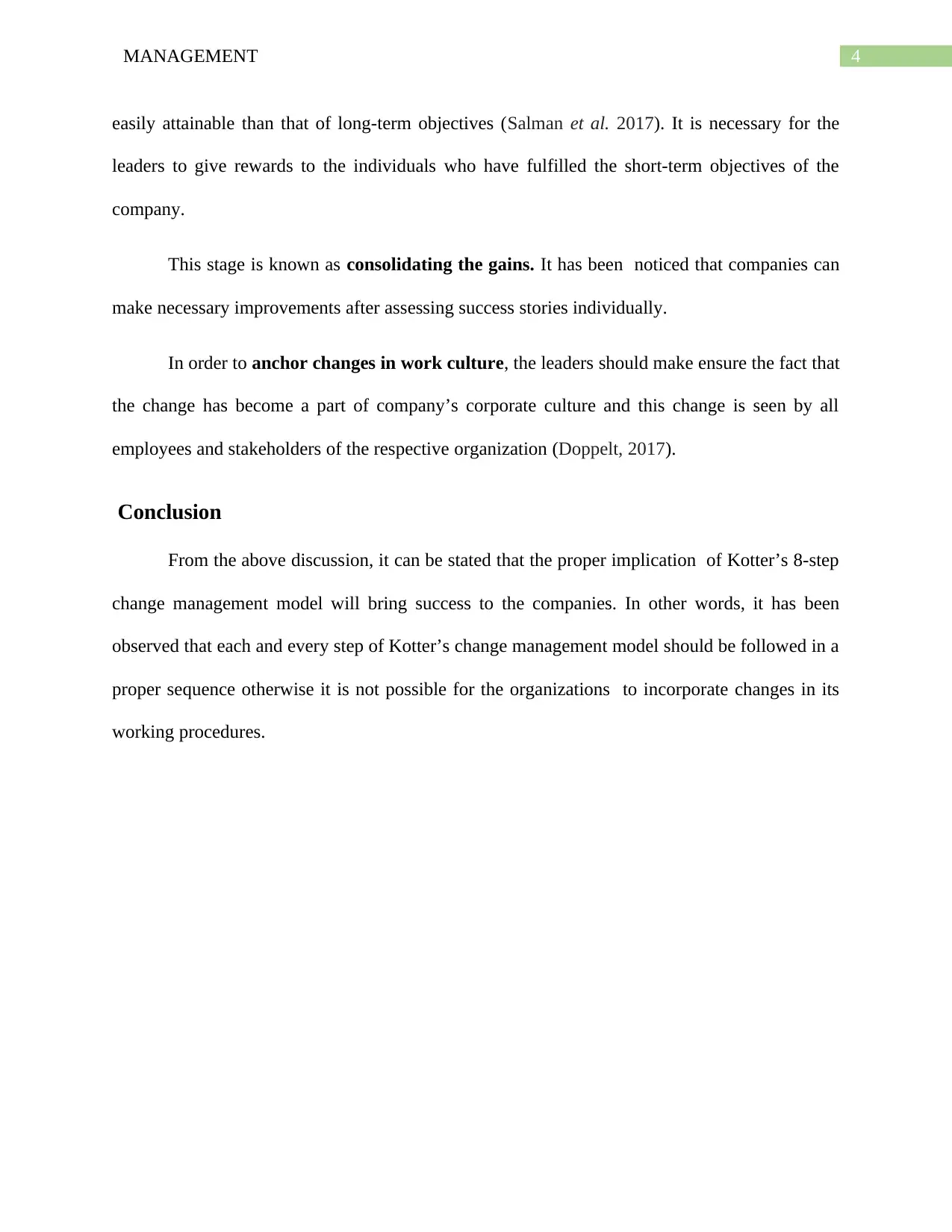
4MANAGEMENT
easily attainable than that of long-term objectives (Salman et al. 2017). It is necessary for the
leaders to give rewards to the individuals who have fulfilled the short-term objectives of the
company.
This stage is known as consolidating the gains. It has been noticed that companies can
make necessary improvements after assessing success stories individually.
In order to anchor changes in work culture, the leaders should make ensure the fact that
the change has become a part of company’s corporate culture and this change is seen by all
employees and stakeholders of the respective organization (Doppelt, 2017).
Conclusion
From the above discussion, it can be stated that the proper implication of Kotter’s 8-step
change management model will bring success to the companies. In other words, it has been
observed that each and every step of Kotter’s change management model should be followed in a
proper sequence otherwise it is not possible for the organizations to incorporate changes in its
working procedures.
easily attainable than that of long-term objectives (Salman et al. 2017). It is necessary for the
leaders to give rewards to the individuals who have fulfilled the short-term objectives of the
company.
This stage is known as consolidating the gains. It has been noticed that companies can
make necessary improvements after assessing success stories individually.
In order to anchor changes in work culture, the leaders should make ensure the fact that
the change has become a part of company’s corporate culture and this change is seen by all
employees and stakeholders of the respective organization (Doppelt, 2017).
Conclusion
From the above discussion, it can be stated that the proper implication of Kotter’s 8-step
change management model will bring success to the companies. In other words, it has been
observed that each and every step of Kotter’s change management model should be followed in a
proper sequence otherwise it is not possible for the organizations to incorporate changes in its
working procedures.
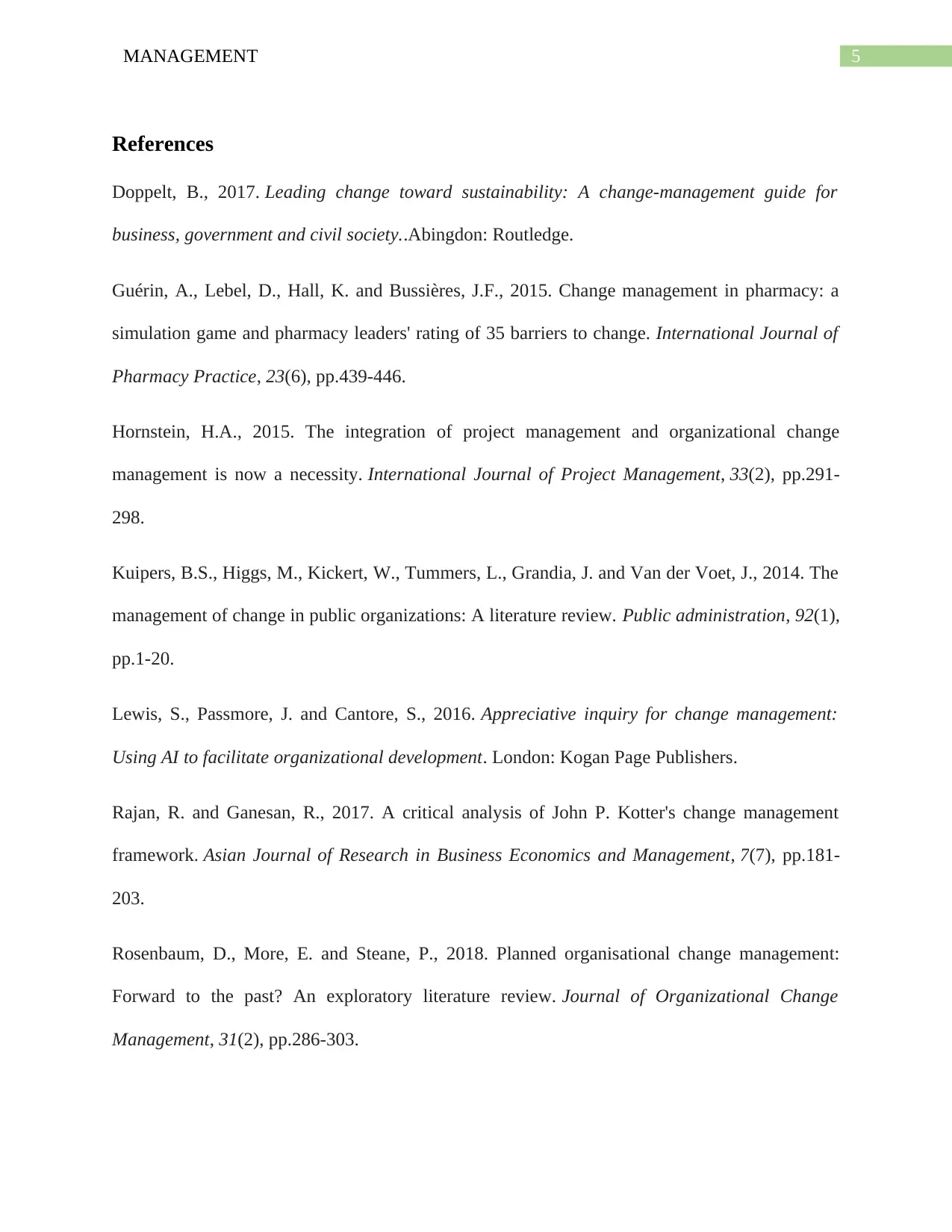
5MANAGEMENT
References
Doppelt, B., 2017. Leading change toward sustainability: A change-management guide for
business, government and civil society..Abingdon: Routledge.
Guérin, A., Lebel, D., Hall, K. and Bussières, J.F., 2015. Change management in pharmacy: a
simulation game and pharmacy leaders' rating of 35 barriers to change. International Journal of
Pharmacy Practice, 23(6), pp.439-446.
Hornstein, H.A., 2015. The integration of project management and organizational change
management is now a necessity. International Journal of Project Management, 33(2), pp.291-
298.
Kuipers, B.S., Higgs, M., Kickert, W., Tummers, L., Grandia, J. and Van der Voet, J., 2014. The
management of change in public organizations: A literature review. Public administration, 92(1),
pp.1-20.
Lewis, S., Passmore, J. and Cantore, S., 2016. Appreciative inquiry for change management:
Using AI to facilitate organizational development. London: Kogan Page Publishers.
Rajan, R. and Ganesan, R., 2017. A critical analysis of John P. Kotter's change management
framework. Asian Journal of Research in Business Economics and Management, 7(7), pp.181-
203.
Rosenbaum, D., More, E. and Steane, P., 2018. Planned organisational change management:
Forward to the past? An exploratory literature review. Journal of Organizational Change
Management, 31(2), pp.286-303.
References
Doppelt, B., 2017. Leading change toward sustainability: A change-management guide for
business, government and civil society..Abingdon: Routledge.
Guérin, A., Lebel, D., Hall, K. and Bussières, J.F., 2015. Change management in pharmacy: a
simulation game and pharmacy leaders' rating of 35 barriers to change. International Journal of
Pharmacy Practice, 23(6), pp.439-446.
Hornstein, H.A., 2015. The integration of project management and organizational change
management is now a necessity. International Journal of Project Management, 33(2), pp.291-
298.
Kuipers, B.S., Higgs, M., Kickert, W., Tummers, L., Grandia, J. and Van der Voet, J., 2014. The
management of change in public organizations: A literature review. Public administration, 92(1),
pp.1-20.
Lewis, S., Passmore, J. and Cantore, S., 2016. Appreciative inquiry for change management:
Using AI to facilitate organizational development. London: Kogan Page Publishers.
Rajan, R. and Ganesan, R., 2017. A critical analysis of John P. Kotter's change management
framework. Asian Journal of Research in Business Economics and Management, 7(7), pp.181-
203.
Rosenbaum, D., More, E. and Steane, P., 2018. Planned organisational change management:
Forward to the past? An exploratory literature review. Journal of Organizational Change
Management, 31(2), pp.286-303.
⊘ This is a preview!⊘
Do you want full access?
Subscribe today to unlock all pages.

Trusted by 1+ million students worldwide
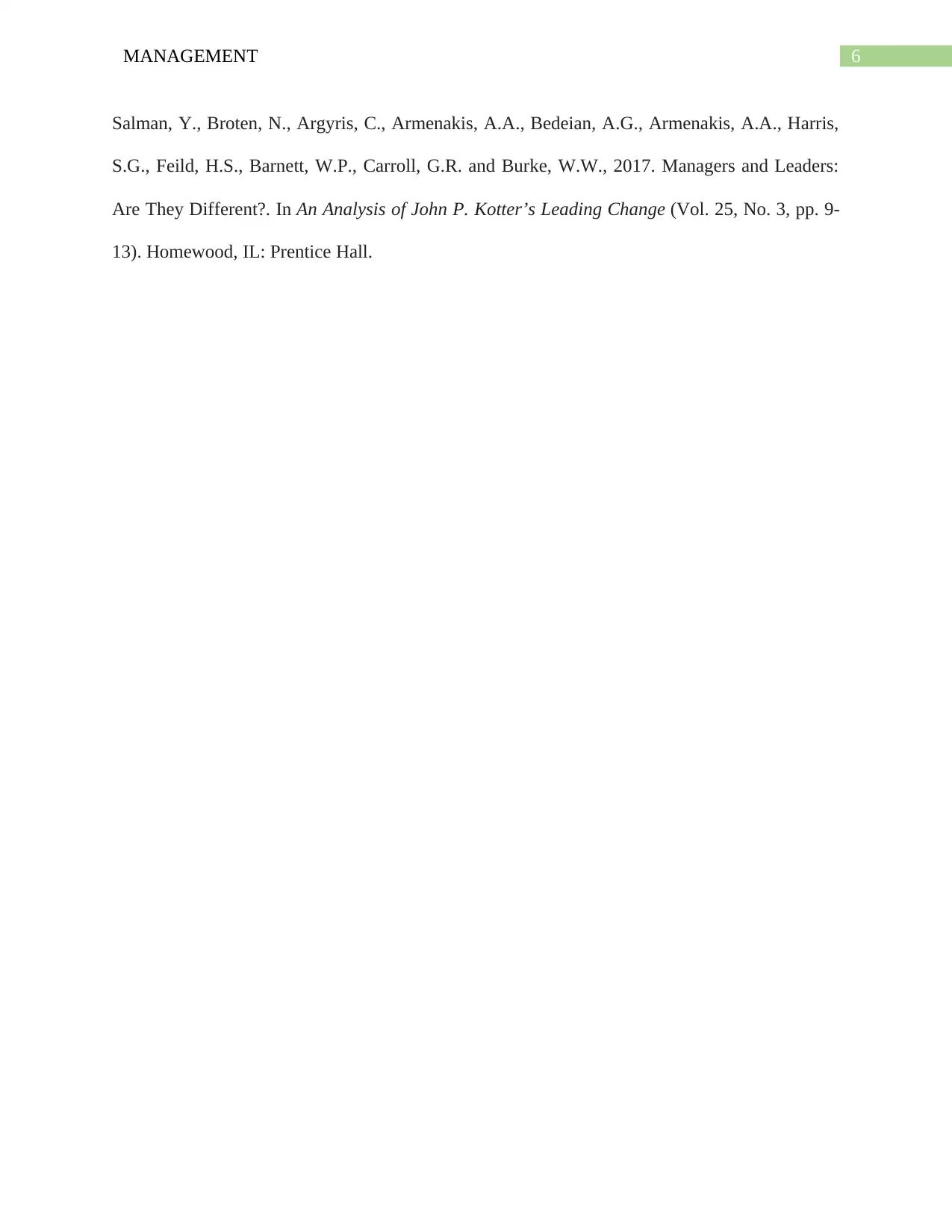
6MANAGEMENT
Salman, Y., Broten, N., Argyris, C., Armenakis, A.A., Bedeian, A.G., Armenakis, A.A., Harris,
S.G., Feild, H.S., Barnett, W.P., Carroll, G.R. and Burke, W.W., 2017. Managers and Leaders:
Are They Different?. In An Analysis of John P. Kotter’s Leading Change (Vol. 25, No. 3, pp. 9-
13). Homewood, IL: Prentice Hall.
Salman, Y., Broten, N., Argyris, C., Armenakis, A.A., Bedeian, A.G., Armenakis, A.A., Harris,
S.G., Feild, H.S., Barnett, W.P., Carroll, G.R. and Burke, W.W., 2017. Managers and Leaders:
Are They Different?. In An Analysis of John P. Kotter’s Leading Change (Vol. 25, No. 3, pp. 9-
13). Homewood, IL: Prentice Hall.
1 out of 7
Related Documents
Your All-in-One AI-Powered Toolkit for Academic Success.
+13062052269
info@desklib.com
Available 24*7 on WhatsApp / Email
![[object Object]](/_next/static/media/star-bottom.7253800d.svg)
Unlock your academic potential
Copyright © 2020–2025 A2Z Services. All Rights Reserved. Developed and managed by ZUCOL.





